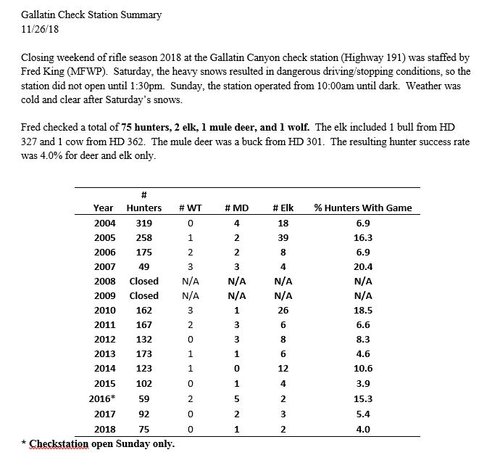Navigation
Install the app
How to install the app on iOS
Follow along with the video below to see how to install our site as a web app on your home screen.
Note: This feature may not be available in some browsers.
More options
You are using an out of date browser. It may not display this or other websites correctly.
You should upgrade or use an alternative browser.
You should upgrade or use an alternative browser.
Can we learn to live with wolves again?
- Thread starter Jasher
- Start date
Idahoarcheryhunter
Well-known member
Come spend a week hunting elk in North Idaho and talk to me about wolf impact... Some of you know what I mean.
belly-deep
Active member
- Joined
- Oct 31, 2009
- Messages
- 3,459
Northwoods Labs, I think Greenhorn gets a special pass on this forum. Not sure why, but he does. The rules don't seem to apply to him.
Actually, GH, I'm glad you will be hunting. I will be too, though not for elk. It will be windy with some snow, but not much. I live well north of Des Moines. If I don't get anything, I'll blame it on wolves.
GH, you really should thank the wolves for all of your hunting. Back when it was "blue ribbon" hunting, you would have filled your tag in the first hour of the season and then been bored sitting in your reading chair blabblering on the internet about things of which you know nothing. What fun would that be.
good luck.
PS. It's taken me quite a few seasons to hunt the length of the Winds. I apologize if you inferred that I claimed to have hunted them in a week or two. Not so.
Brent
When a guy like Greenhorn says the elk numbers are down, you’d be wise to listen. Hint.
BrentD
Well-known member
Brent
When a guy like Greenhorn says the elk numbers are down, you’d be wise to listen. Hint.
Who is to say I disagree? Hint.
get-n-birdy
Well-known member
- Joined
- Dec 8, 2016
- Messages
- 198
The problem with wolf reintroduction efforts isn't the wolf, it's the deception and mismanagement once it's on the landscape. Minnesota, Wisconsin and Michigan are a prime example not to trust reintroduction efforts. We have surpassed target numbers and still can't hunt them. We watch as out west states get to hunt them, yet we are left pissing in the wind.
The lack of management and not allowing hunting will probably result in more wolf deaths vs a legal hunting season. Not saying it's right, but that's how a lot of people are starting to feel in the great lakes regions.
The lack of management and not allowing hunting will probably result in more wolf deaths vs a legal hunting season. Not saying it's right, but that's how a lot of people are starting to feel in the great lakes regions.
noharleyyet
Well-known member
The Hedgehog
Well-known member
The global warming impact/hunter recruitment problem impact.
View attachment 90628
It's crazy to think back to when the Gallatin Canyon supported a late rifle hunt, and there were routinely enough elk around for people to wade the river with archery gear.
BigHornRam
Well-known member
The global warming impact/hunter recruitment problem impact.
View attachment 90628
At least we can still count on Fred King to suffer through the global warming to show up and count all those elk coming through the check station.
The Hedgehog
Well-known member
I stopped by and talked to Fred a couple times, just to make sure he was awake. He’s as good of a guy as there is. Anybody else remember the nice trailer, free coffee and frequent lines at the Gallatin check station?
But hey hunting is good as ever in Montana.
Here’s the only legal bull I saw this year (November 8th) from 3/4 mile then from 588 yards. I had a good angle from 280 and decided to leave him be, knowing I’d be probably kicking myself yesterday at 5PM.
No biggie.
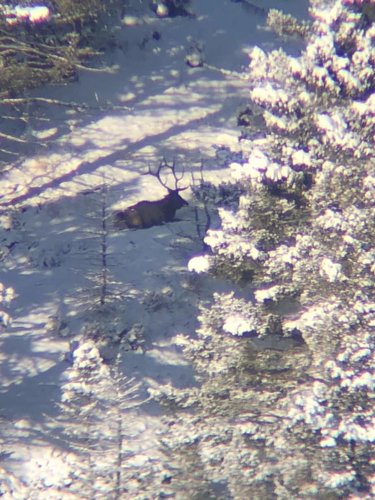
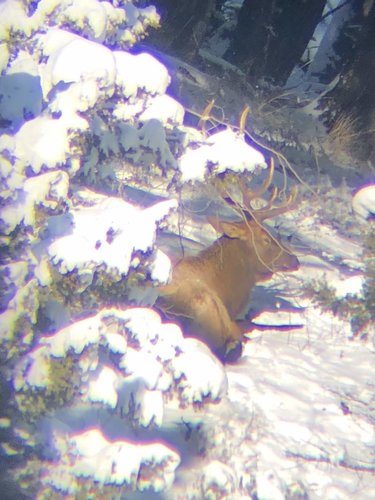
But hey hunting is good as ever in Montana.
Here’s the only legal bull I saw this year (November 8th) from 3/4 mile then from 588 yards. I had a good angle from 280 and decided to leave him be, knowing I’d be probably kicking myself yesterday at 5PM.
No biggie.


Last edited:
T
tjones
Guest
Hey Buzz doesn’t a Hunt talker still owe you a case of beer going back to the MT delisting?
Bambistew
Well-known member
Those harvest rates in the Gallatin are downright depressing. Wow. All that elk habitat, and no elk.
Irrelevant
Well-known member
Those rates are dang near as bad as WA rates.
Sad set of overall #'s there. Global warming must be the leading contributing factor.
Region one had a total of 58 checked elk. The region bordering Canada and Glacier National Park, inclusive of the upper 1/2 Bob Marshal / Great Bear Wilderness, Swan portion, Cabinet Wilderness, etc, etc, etc
Bet it's the poaching. Global warming is along the southern MT border.

This of course covers the five main check stations.
Some perspective: 2010 151 elk were reported at the check stations in Region 1.
Region one had a total of 58 checked elk. The region bordering Canada and Glacier National Park, inclusive of the upper 1/2 Bob Marshal / Great Bear Wilderness, Swan portion, Cabinet Wilderness, etc, etc, etc
Bet it's the poaching. Global warming is along the southern MT border.
This of course covers the five main check stations.
Some perspective: 2010 151 elk were reported at the check stations in Region 1.
Last edited:
antlerradar
Well-known member
The global warming impact/hunter recruitment problem impact.
View attachment 90628
No wonder eastern Montana is full of pickups with 6 plates.
BigHornRam
Well-known member
No wonder eastern Montana is full of pickups with 6 plates.
Got room for some Colorado plates as well?
BuzzH
Well-known member
Sad set of overall #'s there. Global warming must be the leading contributing factor.
Region one had a total of 58 checked elk. The region bordering Canada and Glacier National Park, inclusive of the upper 1/2 Bob Marshal / Great Bear Wilderness, Swan portion, Cabinet Wilderness, etc, etc, etc
Bet it's the poaching. Global warming is along the southern MT border.
This of course covers the five main check stations.
Some perspective: 2010 151 elk were reported at the check stations in Region 1.
Shouldn't be any surprise when looking at the latest population survey, hardly worth the flight time to count 202 elk. Of course I guess its better than flying around unit 202 and observing 8. I bet theres a lot of coffee involved when flying around looking for elk in a lot of Western and Southwestern Montana...
RE: Elk survey in the South Fork Flathead, HDs 140 & 150
Species: Elk Pilot: Rob Cherot and Ken Gustus Total elk observed: 202
Area: HDs 140 & 150 Observer(s): Jessy Coltrane
Calves per 100 cows: 8
Date(s): 20-22 May 2018 Flight time: 9 hours Bulls per 100 cows:6
Aircraft: Cost (@$425.00/hr): $3825
On 20- May 2017, we counted and classified elk from a helicopter in the South Fork of the Flathead River within hunting districts 140 and 150, from Youngs Creek to Dry Parks (Table 1). On 20 May 2018, Rob Cherot was the pilot, and Perry Brown and I were the observers; whereas on the 21 – 22 May, Ken Justus was the pilot and I was the only observer. Low lying meadows were fully green and snowline was high. The south facing slopes, particularly in the 2015 burn areas were also showing signs of emergent vegetation. Youngs Creek was blackened from the 2017 burn with only a few small patches of green vegetation. That drainage was relatively devoid of forage for elk. Skies were clear, and the wind was calm and conditions were optimal for sighting elk. Surveys were conducted from 0600 to 0820.
Unfortunately, this year we had a prolonged winter, with deep snows and late green-up. The helicopter was not available for surveys due to conflicts with other biologists and maintenance requirements, which made it impossible to conduct surveys earlier. Spring green-up conditions were past prime for surveying, and the timing of our survey was also approaching the beginning of calving; we observed several single female elk in heavily wooded areas separate from any herd. Therefore, it appears we missed optimal timing for surveys by over a week, and due to the poor timing of the survey, I would not use these numbers in any trend analysis.
We observed a total of 202 elk, with a calf:cow ratio of 8 calves to 100 cows and a bull:cow ratio of 6 bulls to 100 cows (Table 1; Figures 1 and 2). Elk were observed primarily in meadows and along the main river channel, with the exception of a few single female elk (Figures 3 and 4). Small bands of bulls were observed higher on hillsides and in thick timber. Classifying elk during the spring is relatively difficult, especially discerning bulls from cows. In addition, bulls are in smaller groups in thicker timber, making sightability low in comparison to cow/calf groups. The observed calf:cow ratio is low but similar to last year’s ratio. Bull:cow ratio is lower than observed in previous years (Figure 2).
Shouldn't be any surprise when looking at the latest population survey, hardly worth the flight time to count 202 elk. Of course I guess its better than flying around unit 202 and observing 8. I bet theres a lot of coffee involved when flying around looking for elk in a lot of Western and Southwestern Montana...
RE: Elk survey in the South Fork Flathead, HDs 140 & 150
Species: Elk Pilot: Rob Cherot and Ken Gustus Total elk observed: 202
Area: HDs 140 & 150 Observer(s): Jessy Coltrane
Calves per 100 cows: 8
Date(s): 20-22 May 2018 Flight time: 9 hours Bulls per 100 cows:6
Aircraft: Cost (@$425.00/hr): $3825
On 20- May 2017, we counted and classified elk from a helicopter in the South Fork of the Flathead River within hunting districts 140 and 150, from Youngs Creek to Dry Parks (Table 1). On 20 May 2018, Rob Cherot was the pilot, and Perry Brown and I were the observers; whereas on the 21 – 22 May, Ken Justus was the pilot and I was the only observer. Low lying meadows were fully green and snowline was high. The south facing slopes, particularly in the 2015 burn areas were also showing signs of emergent vegetation. Youngs Creek was blackened from the 2017 burn with only a few small patches of green vegetation. That drainage was relatively devoid of forage for elk. Skies were clear, and the wind was calm and conditions were optimal for sighting elk. Surveys were conducted from 0600 to 0820.
Unfortunately, this year we had a prolonged winter, with deep snows and late green-up. The helicopter was not available for surveys due to conflicts with other biologists and maintenance requirements, which made it impossible to conduct surveys earlier. Spring green-up conditions were past prime for surveying, and the timing of our survey was also approaching the beginning of calving; we observed several single female elk in heavily wooded areas separate from any herd. Therefore, it appears we missed optimal timing for surveys by over a week, and due to the poor timing of the survey, I would not use these numbers in any trend analysis.
We observed a total of 202 elk, with a calf:cow ratio of 8 calves to 100 cows and a bull:cow ratio of 6 bulls to 100 cows (Table 1; Figures 1 and 2). Elk were observed primarily in meadows and along the main river channel, with the exception of a few single female elk (Figures 3 and 4). Small bands of bulls were observed higher on hillsides and in thick timber. Classifying elk during the spring is relatively difficult, especially discerning bulls from cows. In addition, bulls are in smaller groups in thicker timber, making sightability low in comparison to cow/calf groups. The observed calf:cow ratio is low but similar to last year’s ratio. Bull:cow ratio is lower than observed in previous years (Figure 2).
That is great info, to some degree. Any info is better then none - unfortunate that is the limited info available though it's only good as $$$ may buy...
I would be curious for comparison purpose - are you able to run the same info for the area - Region discussed by Greenhorn?
Sad when region 1 had 151 elk checked through those stations in 2010 and ever since it has dwindled down to where we are - 58. Even worse off, from my perspective and maybe even more telling - the hunter count has dropped significantly as well. Hunters are not effected by the past two winters... they go elsewhere to hunt - where elk are more abundant - even though as Greenhorn presented, it is reducing significantly in prior quality opportunities. If those MT boys & girls see #7 plates outside our NW MT area, it's in lieu of the Region 1's lack of elk - though god forbid anyone mentions it could be due to the significant increase in wolf activity and their continuous developing tactics...
Specific stats for FWP Region 1:
(edit: trying to get them added - stay tuned, folks...
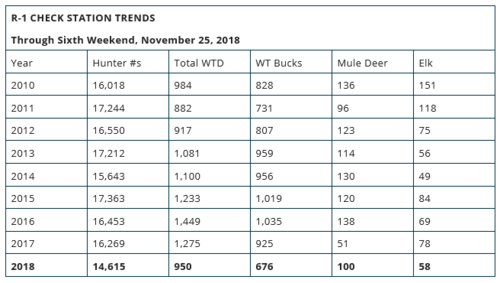
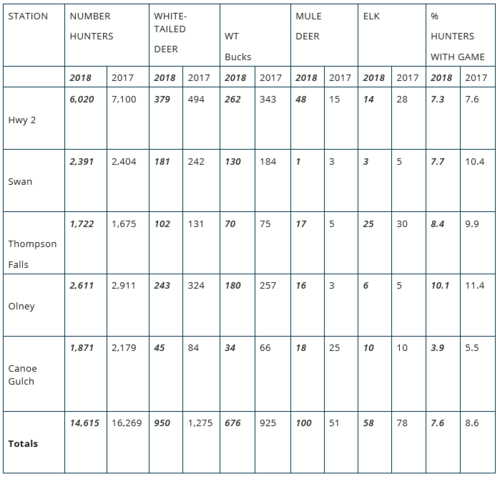
Last edited:
icebreaker12
Active member
The problem with wolf reintroduction efforts isn't the wolf, it's the deception and mismanagement once it's on the landscape. Minnesota, Wisconsin and Michigan are a prime example not to trust reintroduction efforts. We have surpassed target numbers and still can't hunt them. We watch as out west states get to hunt them, yet we are left pissing in the wind.
The lack of management and not allowing hunting will probably result in more wolf deaths vs a legal hunting season. Not saying it's right, but that's how a lot of people are starting to feel in the great lakes regions.
Wolves weren't reintroduced into MI, MN, or WI. And its not to the fault of the states or the feds that the states are unable to manage wolves...
get-n-birdy
Well-known member
- Joined
- Dec 8, 2016
- Messages
- 198
Wolves weren't reintroduced into MI, MN, or WI. And its not to the fault of the states or the feds that the states are unable to manage wolves...
I worded that poorly, my bad.
The target levels have been reached, there is no reason they should still be on the endangered species list in the great lakes region. Wolves were not introduced to MN. But if I lived in a state that didn't have wolves, after seeing the chit show that's gone on with their numbers and what's happening in the court system, I feel for any state that's contemplating introducing them, because once they are there, the ability for a state to manage them isn't an easy option to acquire.
You are correct, it isn't the dnr or usfws's fault.
It's a system that is being manipulated.
Keeping the wolf on the endangered species list, cheapens the value of the list.
Similar threads
- Replies
- 29
- Views
- 1K
- Replies
- 365
- Views
- 18K
- Replies
- 1
- Views
- 761
- Replies
- 35
- Views
- 3K





